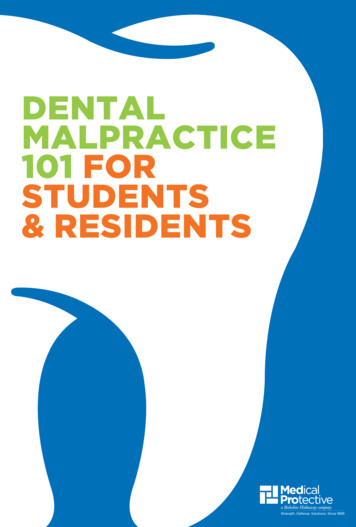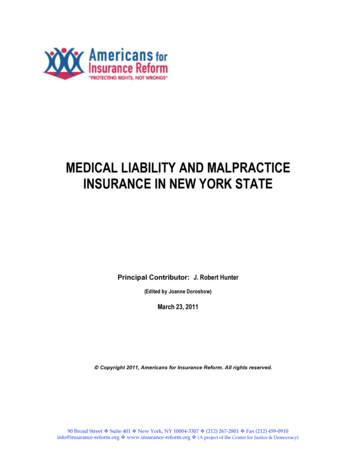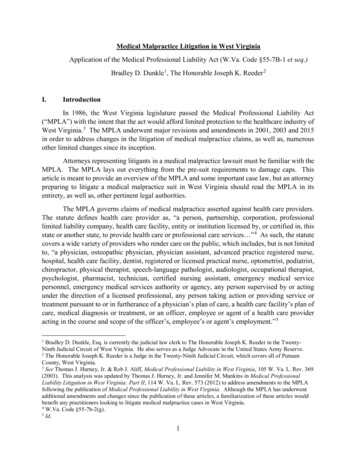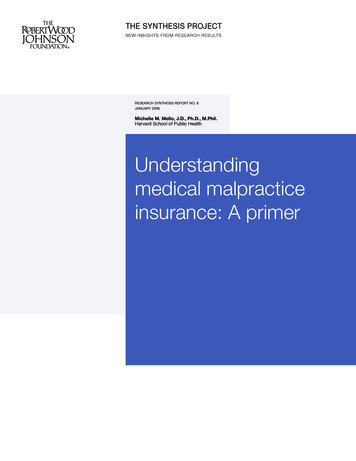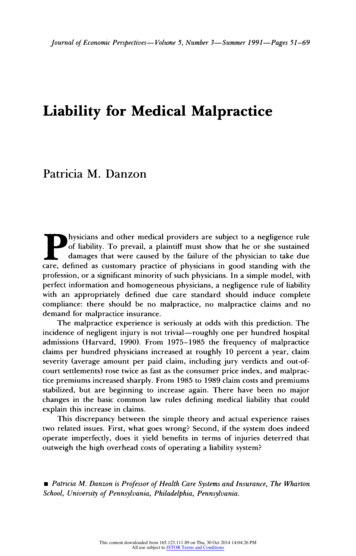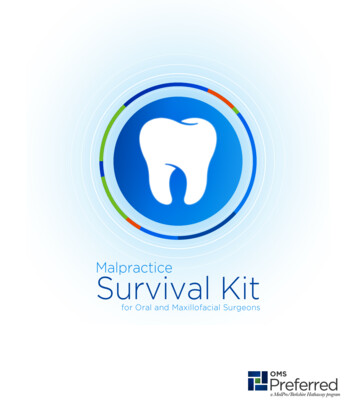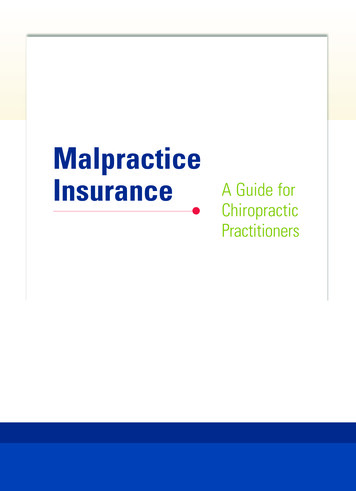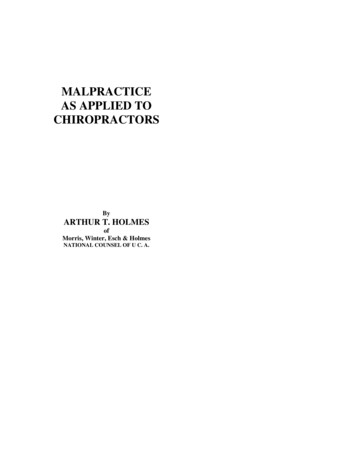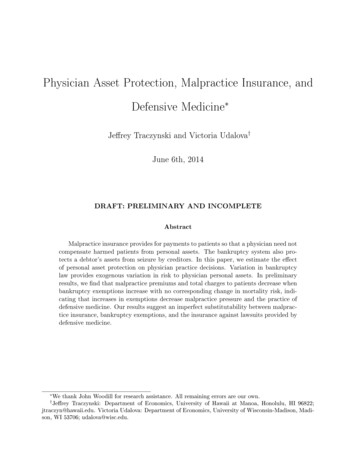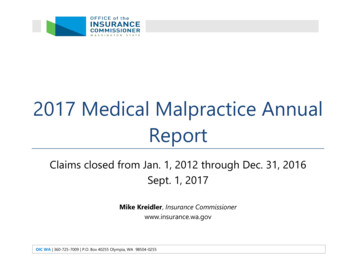
Transcription
2017 Medical Malpractice AnnualReportClaims closed from Jan. 1, 2012 through Dec. 31, 2016Sept. 1, 2017Mike Kreidler, Insurance Commissionerwww.insurance.wa.govOIC WA 360-725-7009 P.O. Box 40255 Olympia, WA 98504-0255
About this reportEarly in the last decade, a “hard market” emerged nationally for most types of insurance. During this period, medical professionalliability insurance became expensive and hard to find for many types of medical providers and facilities.In 2006, the Legislature enacted comprehensive health care liability reform legislation (2SHB 2292) to address a number of concerns,including the cost and availability of medical professional liability insurance. This law also created reporting requirements for medicalmalpractice claims that are resolved and closed, with the intent to collect data to support policy decisions. The OIC began publishingannual reports summarizing the data in 2010.This is the eighth annual report. It includes a snapshot of the medical malpractice marketplace and summary closed claim andsettlement data.This report has three sections:1. The current condition of the medical professional liability insurance market.2. Summarized closed claim data reported by insurers, risk retention groups and self-insurers. 13. Summarized lawsuit-resolution data reported by attorneys.1For simplicity, we will use the term “insurers” when referring to admitted insurers, surplus lines insurers and risk retention groups.2017 Medical Malpractice Annual Report 2
Table of Contents2017 Medical Malpractice Annual Report . 1About this report . 2Key statistics . 5About the medical professional liability insurance market . 5About court verdicts . 6About claim data submitted by insurers and self-insurers . 7About lawsuits filed and settled by attorneys . 10Introduction . 11Snapshot of the medical professional liability insurance market . 14Market participants . 14Loss history . 17Lower claim reserves . 19Washington state market in 2016 . 21The national market in 2016 . 22Information about medical malpractice claims. 24Lawsuit summary . 26Method of settlement . 27Size of indemnity payments . 30Claims with paid indemnity less than and more than 500,000 . 32Defense costs by size of indemnity payment . 33Defense costs for claims with paid indemnity less than and more than 500,000. 35Paid indemnity and defense costs by age of claim . 362017 Medical Malpractice Annual Report 3
Type of insuring entity . 39Severity of injury . 40Type of health care organization . 43Location in the facility . 45Type of medical provider . 47Claim allegations. 51County statistics . 60Gender statistics. 62Age statistics . 63Trends. 65Statistics from medical malpractice lawsuits . 67How lawsuits were settled . 68Settlements by county . 69Gender of plaintiff . 70Age of plaintiff . 71Report limitations . 72Appendices . 74Appendix A: Profitability .75Appendix B: Reserve development.78Appendix C: Rate filing information .81Appendix D: 2015 NAIC profitability report - medical professional liability insurance .842017 Medical Malpractice Annual Report 4
Key statisticsAbout the medical professional liability insurance market The pure loss ratio 2 for 2016 was 48.5 percent. This is similar to recent ratios, which averaged 52.9 percent between 2013 and2015, but much higher than the 36.2 percent average from 2006 to 2012. Defense costs were relatively low in 2016, dropping to 16.2 percent of premium compared to 22.6 percent for 2015. Annual written premiums continued to decline for the sixth straight year, dropping by 3.9 million to 157 million in 2016. Lower claim reserves have fueled profitability since 2007. Insurers have lowered reserves for older claims, leading to lowerincurred loss and defense costs in recent years. 3 For example, Physicians Insurance has lowered reserves by 208 million overits original estimates. Reserves released from prior years translate into profit for the current year. Profitability remains strong, though declining. The operating ratio for Physicians Insurance, the admitted insurer with thelargest market share in Washington, was 90.6 percent in 2016, compared to 87.5 percent for the prior five years. 4 Medical professional liability rates are stable or declining. The most recent physicians and surgeons rate change filingsubmitted to the OIC was a 7.6 percent reduction by Medical Protective Co. for 2015 policies. Washington Casualty Co. filed a10.4 percent rate reduction in 2014. Physicians Insurance has not filed to change its rates since 2009.Pure loss ratio means incurred losses divided by direct earned premium. Incurred losses include paid claims and the change in reserves for pending and unknownclaims. A pure loss ratio does not include defense and cost containment expenses, which are a significant part of the cost to resolve claims.3 Claim reserves are money set aside to meet future payments associated with claims incurred but not settled on a given date. If a claim reserve is too high or aninvestigation shows there is no legal responsibility to pay the claim, the insurer either lowers the reserve or removes the claim reserve from its books. If an insurerlowers total claim reserves for past years, incurred losses are lower in the current year.4 Operating ratios measure overall profitability from underwriting and investment activities. Operating ratios are calculated using countrywide data.22017 Medical Malpractice Annual Report 5
About court verdictsInformation submitted by insurers and self-insurers cannot be directly compared to lawsuit data submitted by attorneys. Insurers andself-insurers report data separately for each defendant, while attorneys submit one final settlement report that includes paymentsmade by all defendants. In spite of these differences, some information reported by both groups about lawsuits is comparable. From 2012 through 2016:ooInsurers and self-insurers paid 25.6 million for plaintiff verdicts or judgments. Judgments and verdicts were few innumber. Of the 20 plaintiff verdicts or judgments, 18 had a payment5 averaging 1.4 million.Attorneys reported that defendants paid 17.4 million to plaintiffs when a lawsuit led to a plaintiff verdict or judgment.Judgments and verdicts were few in number, only six, and resulted in an average payment of 2.9 million. 6 Most claims resolved by the courts end in favor of the defendant. Insurers and self-insurers reported that 164 claims wereresolved by the courts in their favor in 2016, compared to 189 per year on average for the previous four years. Defending lawsuits is costly to insurers and self-insurers. Both groups spent 69.5 million defending lawsuits in which theyultimately prevailed—2.7 times the total indemnity payments for plaintiff judgments or verdicts.In cases where a lawsuit has more than one defendant, some defendants may not be responsible to compensate the claimant.These data suggest that lawsuits that get to the trial stage often have more than one defendant, and the compensation to the plaintiff is higher than the averageindemnity payment reported by insurers and self-insurers.562017 Medical Malpractice Annual Report 6
About claim data submitted by insurers and self-insurersTotal claims: Insurers and self-insurers reported closing 5,237 claims between 2012 and 2016 with an indemnity payment, defensecosts, or both types of payments.7 8 Commercial insurers reported 3,091 claims, self-insured entities reported 1,958 claims, and riskretention groups reported 188 claims. 9Payments to claimants: Insurers and self-insurers paid 618 million on 2,413 claims over the five-year period, or 256,313 per paidclaim. Average indemnity payments over the five-year period varied, from a low of 169,887 in 2012 to a high of 378,525 in 2015.Median indemnity payments were 75,000 in 2015 and 2016, higher than the 50,000 median for the five-year period. Economic loss payments totaled 363 million, an average of 150,520 per paid claim. On average, insurers and self-insurersattributed 58.7 percent of each claim payment to economic loss. Insurers and self-insurers closed 46.1 percent of all claims with an indemnity payment to a claimant. Most, but not all, claimswith paid indemnity also had defense and cost containment expenses. Of the claims closed with an indemnity payment, 7.3 percent closed with a payment of 1 million or more. These claimsaccount for 52.3 percent of total paid indemnity over the five-year period.Defense costs: Insurers and self-insurers paid 251 million to defend 4,437 claims, an average of 56,598 per claim. Average defensecosts were higher in 2016 at 65,481 than in the prior four years, which averaged 54,730.This report includes claims data reported and edited through March 22, 2017.For simplicity, this report substitutes “defense costs” for the technical phase “defense and cost containment expenses.” Defense and cost containment expensesare expenses allocated to a specific claim to defend an insured, including court costs, fees paid to defense attorneys, and fees for expert witnesses. These expensesdo not include the internal costs to operate a claims department.9 Commercial insurers include both admitted and surplus lines insurers.782017 Medical Malpractice Annual Report 7
Method of settlement: Insurers and self-insurers settled most claims with paid indemnity by negotiation between the claimant andthe insurer. For claims with an indemnity payment, insurers and self-insurers settled: 73.7 percent of claims by negotiation, and these settlements comprised 60.3 percent of the total paid indemnity. 18.9 percent of claims by alternative dispute resolution (arbitration, mediation, or private trial). These settlements comprised34.8 percent of the total paid indemnity over the five-year period.Payments by type of medical provider: The insurer or self-insurer identified the type of medical provider in 80.4 percent of theclosed claim reports. 10 Claimants made the remaining claims against an organization, not an individual medical provider. Nursing resulted in the most closed claims at 655. Of these claims, 477 resulted in paid indemnity averaging 156,697. Medianpaid indemnity was 25,000. For physician specialties, general surgery had the most claims at 296, with 125 resulting in paid indemnity averaging 400,469.Median paid indemnity was 100,000. Pediatrics had the highest average paid indemnity of 1.2 million, with median paidindemnity of 300,000.Payments and defense costs by age of claim:10 The more time that passed between when the insurer or self-insurer was notified of a claim and when the claim was settled,the higher the payments for the claim tended to be. Claims closed within the first year had average paid indemnity of 47,380.Claims that took at least five years to settle had average indemnity payments of 761,604. The amount paid for defense costs also increased with the age of the claim. For the 1,162 claims with defense costs closedwithin one year after report date, average defense costs were 6,919. That figure rose to 37,290 for 1,509 claims that closedin the second year. The 177 claims with defense costs that closed five or more years after report date had average defensecosts of 224,169.Physician specialties, dental specialties and other types of medical providers.2017 Medical Malpractice Annual Report 8
Regional comparisons: Just under one-third of the claims, or 1,606, were in King County. Of these, 48.1 percent resulted inindemnity payments totaling 213.8 million, an average of 276,984 per claim.Allegations: Improper performance was the most common allegation, with 1,004 claims and 470 indemnity payments that averaged 147,236. Vicarious liability was the second-most common allegation, with 771 claims and 271 indemnity payments that averaged 301,948.2017 Medical Malpractice Annual Report 9
About lawsuits filed and settled by attorneysIf an attorney files a lawsuit to resolve a medical malpractice incident, he or she should report data about the lawsuit to the Office ofthe Insurance Commissioner (OIC) once the litigation is resolved. For settlements resolved between 2012 and 2016:Compensation to claimants: Attorneys reported that claimants received total compensation of 312.9 million on 250 claims, anaverage of 1.3 million per settlement. Attorney fees were 111.9 million, an average of 511,850 per reported settlement. Onaverage, the attorney fees were 35.8 percent of the total compensation paid to the claimant.How lawsuits settled: When an indemnity payment was made, 41.3 percent of lawsuits were settled in mediation. Mediatedsettlements had an average indemnity payment of 1.2 million and an average legal fee of 504,509. Only six lawsuits were reportedas resolved by jury verdicts in favor of the plaintiff. These verdicts resulted in total paid indemnity of 17.4 million, an average of 2.9million per case.Regional comparisons: The largest number of lawsuits were filed in King County, with 124 lawsuits, or 49.6 percent of the statewidetotal. Average paid indemnity in King County was 1.3 million. A few extremely large settlements in the North Sound region in 2015resulted in the highest average paid indemnity for any region of 3 million.Settlement by age of claimant: The most expensive settlements involved patients younger than 11 years old. In cases involvingnewborns and infants, the average settlement was 2.5 million and the average legal expense was 968,804. For patients betweenone and 10 years old, there were four settlements averaging 4.4 million in paid indemnity and 1.9 million in legal expenses.2017 Medical Malpractice Annual Report 10
IntroductionUnder chapter 48.140 RCW, insurers, risk retention groups (collectively “insurers”) and self-insurers must submit a report to the OICevery time they close a medical malpractice claim. 11 Under RCW 7.70.140, attorneys must report aggregate settlement data from alldefendants after they resolve all claims related to a medical malpractice lawsuit. This report includes data submitted by insurers, selfinsurers and attorneys in summary form that protects the confidentiality of people and organizations involved in the claim orsettlement process. 12Insurers, self-insurers and attorneys must report claim data for the prior year to the OIC by March 1 of each year. 13 Attorneys’compliance with the reporting law has been low, and the OIC does not have enforcement mechanisms to improve compliance. 14 As aresult, this report provides very few summary exhibits for settlement data reported by attorneys, since the OIC cannot drawconclusions from incomplete data. Most of the exhibits in this report focus on data reported by insurers and self-insurers. 15This report has three sections:1) Market analysisThis section is an overview of the medical professional liability insurance market in Washington and around the country that includes: An analysis of the profitability of the largest authorized medical malpractice insurers in Washington.A risk retention group (RRG) is an owner-controlled insurance company authorized by the Federal Risk Retention Act of 1986. An RRG provides liability insuranceto members who are in similar or related business or activities. The federal act allows one state to charter an RRG and allows the RRG to engage in the business ofinsurance in all states. The federal act pre-empts state law in many significant ways. See RCW 49.92.030(1). For simplicity, and to protect confidentiality of data, weinclude them with all other insurers in this report.12 RCW 48.140.040(3) says the OIC must take steps to protect the confidentiality of claim data, and RCW 48.140.060 required the OIC to adopt rules to achieve thisresult.13 See RCW 48.140.020(2) and WAC 284-24E-090.14 In 2010, the OIC proposed legislation, which the Legislature did not enact, that would have added enforcement mechanisms to the existing law. These bills wereintroduced as SB 6412 and HB 2963.15 RCW 48.140.050 lists information that must be provided by this report.112017 Medical Malpractice Annual Report 11
Information about medical malpractice rate changes approved last year. Information about incurred losses and defense costs for medical professional liability insurance.2) Closed claim statistics reported by insurers, risk retention groups and self-insurersInsurers and self-insurers report claims they close with an indemnity payment and/or defense costs.16associated with one defendant. 1817Each closed claim report isPeople make medical malpractice claims for a variety of reasons, or allegations. People can make allegations against an organization,such as a hospital, against a medical provider, or both.Insurers and self-insurers reported three primary types of closed claim data:1. Defense costs: These are expenses paid to defend claims, and include expenses allocated to a specific claim, such as courtcosts and fees paid to defense attorneys or expert witnesses. They do not include internal costs to settle claims, such assalaries for claims staff or operating overhead for a claims department. 192. Economic damages: Most of these amounts are estimates of the claimant’s economic damages made by the insurer or selfinsurer when it makes a payment to settle the claim. 20 In a few cases, a court itemized economic damages when it issued averdict, and these amounts are included in the totals.3. Paid indemnity: The amount the insurer or self-insurer paid to the claimant to resolve the claim.RCW 48.140.010(1) defines a claim.Under WAC 284-24D-060, if an insurer or self-insurer closes a claim without an indemnity payment or defense costs, it is not required to report the claim to theOIC.18 RCW 48.140.010(3) defines a closed claim.19 See WAC 284-24D-020(1), WAC 284-24D-330 and WAC 284-24D-340.20 See RCW 4.56.250(1)(a), WAC 284-24D-350, WAC 284-24D-360, WAC 284-24D-362, WAC 284-24D-364, and WAC 284-24D-370.16172017 Medical Malpractice Annual Report 12
3) Lawsuit statistics reported by attorneysIf an attorney files a lawsuit alleging medical malpractice, the attorney must report data after the lawsuit is resolved. Many attorneys,however, do not comply with RCW 7.70.140, so data in this report are incomplete. The OIC cannot draw conclusions from incompletedata, so the section of the report containing data submitted by attorneys is less detailed than the closed claim section.Attorneys report two primary types of settlement data:1. Total paid indemnity: Total compensation paid by all defendants to the claimant as the result of the lawsuit. Indemnitypayments may come from several defendants if a lawsuit named more than one party. 212. Legal expenses: All sums paid by the claimant to the attorney, including attorney fees, expert witness fees, court costs, and allother legal expenses. 22 23Closed claim and lawsuit statistics are differentOne cannot compare data reported by insurers and self-insurers to the data reported by attorneys because insurers and self-insurers: Report all closed claims if the insurer or self-insurer makes payments or incurs expenses to defend the claim. Attorneys reportdata only if they filed a lawsuit against one or more defendants. Report data separately for each defendant. Attorneys submit one final settlement report that includes payments made by alldefendants they sued.Example: If an attorney sues several medical providers for their actions related to an incident with a poor medical outcome, some providers mayresolve the litigation early, while others may be involved in the dispute resolution process for years. Insurers and self-insurers report claims as theyresolve the claims against their customers, while an attorney waits until claims against all defendants are resolved to report the settlement.One final reason the OIC cannot make comparisons: Insurers, self-insurers and risk retention groups have been much more diligent inreporting closed claim data.WAC 284-24E-150.Attorney fees for legal representation are generally contingent fees that are payable if indemnity payments are made by one or more defendants.23 RCW 7.70.140(2)(b)(v).21222017 Medical Malpractice Annual Report 13
Snapshot of the medical professional liabilityinsurance marketThis section of the report provides an overview of the medical malpractice market in Washington primarily using calendar yearpremium and loss data obtained from the National Association of Insurance Commissioners (NAIC).Market participantsThe medical professional liability insurance market has three primary participants: Admitted insurers regulated by the OIC. Unregulated surplus lines insurers. Risk retention groups regulated by their home state.In 2000, admitted insurers wrote 95.4 percent of medical professional liability insurance premiums in Washington. PhysiciansInsurance Group led the market with 52.7 percent of the admitted market share and 50.3 percent of total market share. 24 By 2016, theadmitted market wrote only 67.6 percent of premium, and the remainder of the market belonged to surplus lines insurers and riskretention groups. Physicians Insurance still had about half of the admitted market share at 53.8 percent, but its share of the overallmarket was much lower at 36.4 percent.Medical professional liability insurance has been a profitable line of business for insurers in Washington for some time. While recentprofit margins have been good, they have not been as good as in the last half of the last decade. Compare the 2006-2010 operatingIn 2000, Physicians Insurance Group sold insurance through three companies: Physicians Insurance, A Mutual Company; Western Professional InsuranceCompany; and Northwest Dentists Insurance Company. Western Professional Insurance Company is no longer actively writing insurance, and a group including theODS Companies and the Washington State Dental Association purchased Northwest Dentists Insurance Company in 2007.242017 Medical Malpractice Annual Report 14
ratio for Physicians Insurance of 63.9% with the 2011-2016 ratio of 88% ratio. Written premiums in the state have fallen 42% since2004. Though the trend seems to be slowing, physicians, particularly younger physicians, continue to move away from independentpractice and seek employment in large groups and hospitals. A shrinking malpractice insurance market has led to highly competitiveconditions.2017 Medical Malpractice Annual Report 15
MillionsThis chart shows the distribution of written premiums for each segment of the medical professional liability insurance market.Premiums for admitted insurers and surplus lines insurers have declined significantly since 2004.Premiums by Market Segment 300 250 15 15 21Direct written premium 20 200 84 78 63 53 20 46 150 18 18 20 42 47 41 21 45 23 36 22 31 22 21 29 30 111 10620152016 100 171 170 171 167 149 141 139 144 135 130 12420132014 50 -200420052006200720082009Admitted insurer2017 Medical Malpractice Annual Report 1620102011Surplus lines2012RRG
Loss histo
2017 Medical Malpractice Annual Report Claims closed from Jan. 1, 2012 through Dec. 31, 2016 Sept. 1, 2017 . Mike Kreidler, Insurance Commissioner . Physicians Insurance has not filed to change its rates since 2009. 2 Pure loss ratio means incurred losses divided by direct earned premium. Incurred losses include paid claims and the change in .
